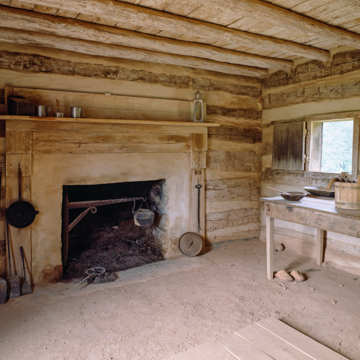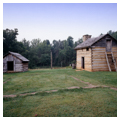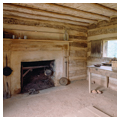Booker T. Washington was born into slavery in 1856 in a log cabin on the tobacco plantation of James and Elizabeth Burroughs. In his autobiography, Up from Slavery (1901), Washington recounts the story of his hardscrabble childhood and evolution into a major educational and cultural figure of his time. The pragmatic Washington not only established in 1881 a school for African Americans in Alabama that became Tuskegee Institute but also helped lead America's blacks and whites to a better understanding of each other. A replica of the one-room cabin where he lived as a child has been constructed along with other outbuildings and a center for interpreting this history. In his autobiography, Washington wrote of his childhood home, “The cabin was not only our living-place, but was also used as the kitchen for the plantation. . . . The cabin was without glass windows; it had only openings in the side which let the light in, and also the cold, chilly air of winter. There was a door to the cabin—that is, something that was called a door—but the uncertain hinges by which it was hung, and the large cracks in it, to say nothing of the fact that it was too small, made the room a very uncomfortable one . . . we slept in and on a bundle of filthy rags laid upon the dirt floor.”
You are here
Booker T. Washington National Monument
If SAH Archipedia has been useful to you, please consider supporting it.
SAH Archipedia tells the story of the United States through its buildings, landscapes, and cities. This freely available resource empowers the public with authoritative knowledge that deepens their understanding and appreciation of the built environment. But the Society of Architectural Historians, which created SAH Archipedia with University of Virginia Press, needs your support to maintain the high-caliber research, writing, photography, cartography, editing, design, and programming that make SAH Archipedia a trusted online resource available to all who value the history of place, heritage tourism, and learning.




